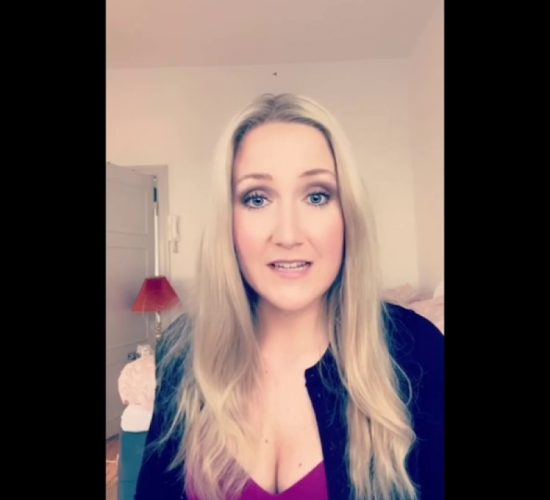Signe Jensen’s Lyme Hack:
“Hi guys. So because May is Lyme disease Awareness Month, I have decided in collaboration with Tick Boot Camp to make a small video for you guys, where I explain a tip that has really helped me to deal with my Lyme disease. And the thing that I would like to talk about today is energy management. And I would like to share a tip with you guys that can help you to maintain a daily routine, even though you are struggling with chronic pain and therefore have a decreased amount of energy. And the reason that I would like to talk about energy management today is that a lot of us Lymies, we struggle with fatigue, which means that we often don’t have enough energy to do all the things that we would like to do. And because of that, I think it’s very important to learn how to manage your energy in a way that allows you to maintain a daily routine without feeling tired and exhausted all the time. And the technique I’m going to be sharing with you guys today is actually a technique I learned before I got Lyme disease. And because before I got Lyme disease, I was sick for about seven years with a long term concussion, which also gave me a lot of fatigue. But this technique has really helped me to maintain a normal life. And I hope that it can also help some of you guys and the technique that I’m using is based on the view that you can typically have two different behavior patterns when dealing with chronic pain. You can choose to deny your pain or you can choose to accept your pain. In the beginning of my illness, I would always choose to deny my pain as an example, If I had spent a few days in bed because I was too sick to do anything, I would end up feeling really guilty because I would then feel that I was behind on my studying or feeling sad because I had missed social events. And because of that, as soon as I felt better, and were able to leave the bed, I will then try to catch up by studying too much, or by making a lot of plans with my friends, because I was so desperate to like catch up for the time that I had lost. And the result was that after a few days in bed, I would always have a few days where I were extremely active, and trying to catch up for the time that I had lost. But during these very active days, I would always use more energy than I actually had because I was so keen on catching up with the things I hadn’t been able to do. And the result would be that after a few very active days, I would again feel completely exhausted, and then I would be back in bed. So following this denial pattern, I would typically have two very active days. And then I would maybe have three or four days back in bed, trying to recover from all the activities, and then I would go out again for a few days be very active and then back in bed. After being ill for several years, I finally learned how to follow the acceptance pattern. And the key to understanding this pattern is that you have to imagine that you have a certain amount of energy blocks to use each week and for a normal, healthy person, let’s say that a person has four energy blocks to use each day. But the thing you have to realize when you have a chronic disease is that your disease takes up some of your energy blocks. So instead of having four energy blocks per day, you only have two, because being ill uses some of your energy and you have to adjust your life to that. So living with a chronic disease means that you only have 14 energy blocks compared to the 28 of a healthy person. And the task is then to learn to divide these energy blocks and the different things that you would like to do. And it’s very important that you never use more energy blocks than you have. For example, for me, I have a full time job. So I have to accept that I have to use many of my energy blocks on my job, and that I only have a limited amount of energy blocks to use on family and friends and also exercise which is a big part of my life. The important thing to understand is that if you are using a lot of energy blocks on one thing, you have to pay them back by giving yourself some time to recover. If you are constantly using more energy blocks than you have, and you’re denying the science from your body, you will actually end up having even less energy than you would if you were listening to your body instead and planning your schedule according to that. Remember how I told you before that when I was following the denial pattern, I would typically have a few very active days. Then I will spend the rest of my time in bed feeling exhausted. In that case, you could say that my activity curve was fluctuating a lot. Following the acceptance pattern instead, you typically have a much more flat activity curve. You don’t have any days where you are out overdoing it and trying to squeeze a lot of different activities into one day. Instead, you have a few activities each day, but each day you also allow yourself some time to recover. Following this behavioral pattern, you are accepting the fact that you have a limited amount of energy and you are planning your days according to that. This technique has really helped me to deal with my Lyme disease, because I have learned to manage my time in a way that allows me to keep a full time job and actually feel okay. Even though I have a chronic illness, I think the amazing thing about this technique is that once I started accepting my illness and the fact that I have a decreased amount of energy, and when I started planning my time according to that, I actually ended up being able to do more things and having more energy than I did when I was trying to deny my illness. And I was trying to live my life the way I did before I got ill. So I really hope that this technique can also help some of you guys and if you have any questions, you’re always welcome to ask me. I would like to say thank you to Tick Boot Camp for inviting me to do this video. And I really hope that it can help some of you and I would also just like to wish you all a wonderful day. Take care And stay safe. Bye.”






